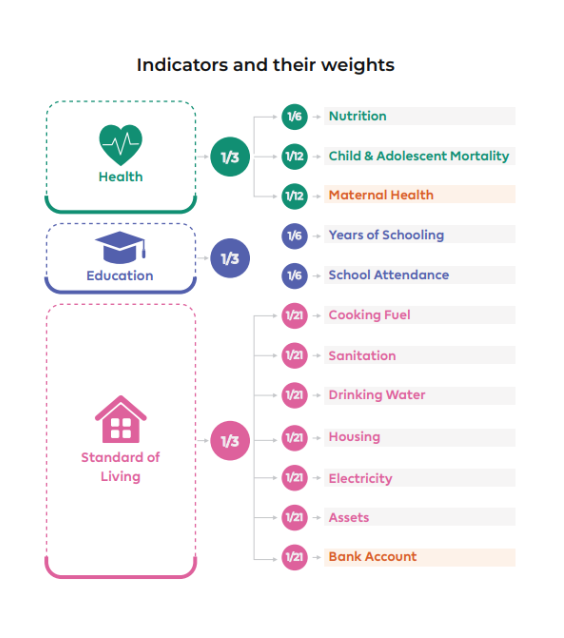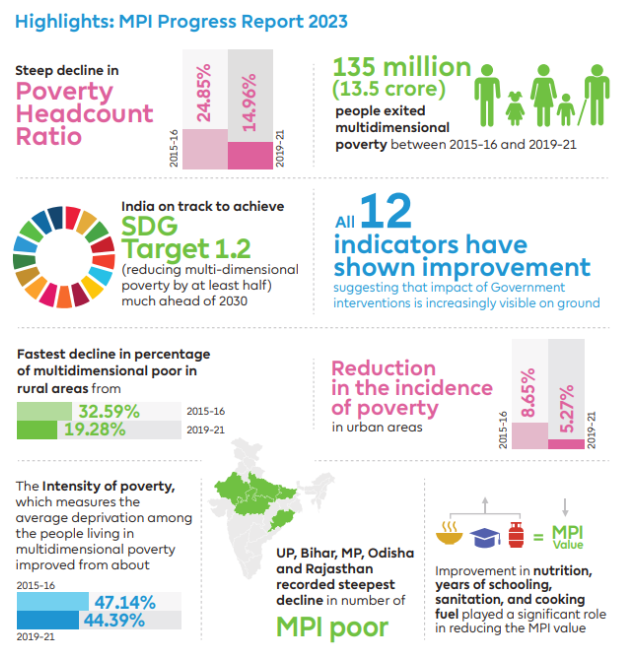20 Jul National Multidimensional Poverty Index
This article covers “Daily Current Affairs” and the topic details “National Multidimensional Poverty Index”. The topic “National Multidimensional Poverty Index” has relevance in the “Economic and Social Development” section of the UPSC CSE exam.
For Prelims:
What is the National Multidimensional Poverty Index? Who releases the index? What are its dimensions and indicators?
For Mains:
GS2: Issues related to Poverty and Hunger
GS3: Inclusive Development
Why in the News?
The NITI Aayog has released the second edition of the Multidimensional Poverty Index report named ‘National Multidimensional Poverty Index: A Progress Review 2023’.
What is Multidimensional Poverty?
- Most countries define poverty as a lack of money, but the poor themselves view poverty in a broader context.
- They experience multiple disadvantages simultaneously, including poor health, malnutrition, lack of clean water or electricity, low-quality work, and limited education. Focusing solely on income fails to capture the full reality of poverty.
- Multidimensional poverty measures offer a more comprehensive understanding by depicting who is poor and the various disadvantages they face.
- These measures not only provide an overall poverty indicator but also allow for analyzing poverty levels in different regions and among different sub-groups.
National Multidimensional Poverty Index
-
- The Government of India has acknowledged the significance of the global MPI.
- NITI Aayog has been responsible for constructing an indigenized index for monitoring the performance of States and Union Territories in addressing multidimensional poverty.
- The national MPI model keeps the ten indicators of the global MPI model, remaining closely aligned with the global methodology.
- It also includes two new indicators, namely Maternal Health and Bank Accounts, which are in line with national priorities.
Sub-indices of the National MPI
- As per the Alkire-Foster (AF) methodology, an individual is considered multidimensionally poor or MPI poor if they experience deprivation in at least one-third of the weighted MPI indicators. Simply put, a person is deemed MPI poor if their weighted deprivation score reaches or exceeds the poverty threshold of 33.33%.
- Headcount ratio (H): How many are poor?
-
- Proportion of multidimensionally poor in the population, which is arrived at by dividing the number of multidimensionally poor persons by total population.
- Intensity of poverty (A): How poor are the poor?
-
- The average level of deprivations experienced by individuals living in multidimensional poverty is determined by calculating the intensity. This involves adding up the weighted deprivation scores of all poor individuals and dividing the sum by the total number of poor individuals.
- MPI value is arrived at by multiplying the headcount ratio (H) and the intensity of poverty (A), reflecting both the share of people in poverty and the degree to which they are deprived.
MPI = H × A
National MPI 2023
- The National Multidimensional Poverty Index: A Progress Review 2023 is the second edition of the national MPI and follows up on the Baseline Report published in November 2021. It provides an update on the progress made in reducing multidimensional poverty in the country.
- It provides multidimensional poverty estimates for India’s 36 States & Union Territories, along with 707 administrative districts across 12 indicators of the national MPI.
- These estimates were calculated using data from the 5th round of the National Family Health Survey (NFHS-5), which was conducted in 2019-21, using the same methodology as the baseline report.
- This edition also presents the changes in multidimensional poverty between the survey periods of NFHS-4 (2015-16) and NFHS-5 (2019-21).

National MPI 2023 – Key findings
- Key findings from the National MPI 2023 Report reveal that India has made significant progress in reducing multidimensional poverty. The percentage of multidimensionally poor individuals in India has decreased from 24.85% in 2015-16 to 14.96% in 2019-2021, marking a remarkable decline of 9.89 percentage points.
- The rural areas of the country experienced the most rapid reduction in poverty, with the poverty rate dropping from 32.59% to 19.28%. Similarly, urban areas witnessed a decrease in poverty from 8.65% to 5.27% during the same period.
- Uttar Pradesh witnessed the most significant decrease in the count of impoverished individuals, as 3.43 crore people successfully lifted themselves out of multidimensional poverty.
- Uttar Pradesh, Bihar, Madhya Pradesh, Odisha, and Rajasthan demonstrated the swiftest reduction in the percentage of people living in multidimensional poverty.
- Additionally, the MPI value has nearly halved from 0.117 to 0.066 between 2015-16 and 2019-21, indicating significant progress.
- The intensity of poverty, which measures the average deprivation among the poor, also declined from 47.14% to 44.39%.
- These positive trends demonstrate that India is on track to achieve SDG Target 1.2, which aims to reduce multidimensional poverty by at least half, well ahead of the set timeline of 2030.

Government Schemes related to MPI Indicators:
- Prominent initiatives such as the Poshan Abhiyan and Anaemia Mukt Bharat have made notable contributions to diminishing health-related deprivations.
- The Swachh Bharat Mission (SBM) and Jal Jeevan Mission (JJM) have successfully enhanced sanitation levels throughout the nation, as evidenced by a substantial improvement of 21.8 percentage points in sanitation deprivations.
- The implementation of the Pradhan Mantri Ujjwala Yojana (PMUY), which offers subsidized cooking fuel, has had a significant positive impact on people’s lives. This initiative has resulted in an impressive improvement of 14.6 percentage points in addressing cooking fuel deprivations.
- Furthermore, initiatives like Saubhagya, Pradhan Mantri Awas Yojana (PMAY), Pradhan Mantri Jan Dhan Yojana (PMJDY), and Samagra Shiksha have played crucial roles in significantly reducing multidimensional poverty across the country.
Other Indices and Reports of NITI Ayog include:
- SDG India Index
- Export Preparedness Index
- India Innovation Index
- Healthy States, Progressive India: Health Index
- SDG Urban Index
- Data Governance Quality Index
- State Energy and Climate Index
- Composite Water Management Index
- India’s Booming Gig and Platform Economy
- School Education Quality Index (SEQI)
Sources:
Niti Aayog report claims decrease in multidimensional poverty
plutus ias current affairs eng med 20th July 2023
Q1. According to the National Multidimensional Poverty Index (MPI) methodology, which of the following accurately represents the determination of multidimensional poverty in India?
(a) An individual is considered multidimensionally poor if they experience deprivation in at least one-third of the weighted MPI indicators.
(b) An individual is considered multidimensionally poor if they experience deprivation in all of the weighted MPI indicators.
(c) An individual is considered multidimensionally poor if they experience deprivation in at least two -third of the weighted MPI indicators
(d) An individual is considered multidimensionally poor based on their educational attainment alone.
Answer: (a)
Q2. Consider the following:
- SDG India Index
- Export Preparedness Index
- India Innovation Index
- Energy Performance Index
- Data Governance Quality Index
- Performance Grading Index for Districts (PGI-D)
How many of the abovementioned reports and indices are released by NITI Aayog?
(a) Only three
(b) Only four
(c) Only five
(d) All Six
Answer: (b)
Q3. Discuss India’s recent success in addressing multidimensional poverty and outline the roadmap for further progress.



No Comments